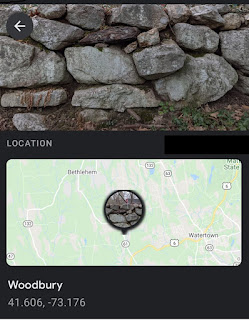Pages
Sunday, October 31, 2021
Located that Other House
Saturday, October 23, 2021
Stone Serpents at the Nonnewaug Watch House
Cutting down the summer's screen of iris and fern and phlox, at the Nonnewaug Watch House, the stone serpents that make up the retaining wall in the front of the house are more easily seen.
Monday, October 18, 2021
Culvert-like & Causeway-like (Paugussett Homeland CT)
Big Stone Snakes (Nonnewaug in the Paugussett Homeland)
Curtiss
Hoffman, in Stone Prayers; Native
American Stone Constructions of the Eastern Seaboard, writes about what are
commonly known as “stone walls.” There
are some he classifies some as “(Indigenous) Stone Rows” as well as identifying
others as Serpent or Snake Effigies:
“Some of the more remarkable rows (of
stones) have what appear to be serpent heads at their ends. These and the more
sinuous walls have been reclassified within the effigies category." (Page 61)
Located where I am in the Nonewaug (Nonnewaug) Cluster (CT #3), as it is designated in Stone Prayers, I don’t really agree entirely with many of the vast number of people who write about “the stone walls of New England,” from Eric Sloane to the most recent writers who claim a post-contact European origin for the vast majority of these “rows of stones.”
(For Example: https://wakinguponturtleisland.blogspot.com/2020/03/on-viewing-video-presentation-of.html )
For example, I just don’t observe the evidence on the ground that the abundance of zigzag stone walls here resulted in the much repeated “thrown up against a wooden Virginia or Snake Rail fence” hypothesis. It may have taken a long time to identify the snake imagery distinguishing characteristics in the purposeful construction methods of these rows of stones but to date I see haven’t found a single one that fits the original Sloane explanation of their origin, no matter how many times I hear it repeated. I find myself agreeing with the geologist Robert Thorson when he writes that there is really a “dearth” of actual scientific investigation into these iconic landscape features people love to write and hear about.
Here in Nonnewaug, one can observe many zigzag rows of culturally stacked stones that suddenly turn into linear rows as well as find the scarce few that are still topped with the remnants of chestnut rails, sometimes simply by driving along the Indigenous “trails” that have been paved to become modern roads. I hypothesize that if Indigenous Peoples used fire to shape the landscape as in other places in the western hemisphere, then these rows of stones would often very efficiently serve as fuel breaks that illustrate a system of control of those fires.
(And then
I look at the sukq part of the word
poem, ponder if that just might be a variant of a word for snake…)
https://wakinguponturtleisland.blogspot.com/2019/06/nonnewaug-stone-rows.html

















































